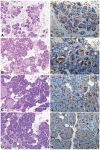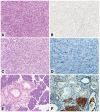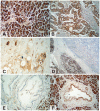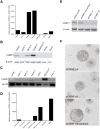Retinoid signaling in pancreatic cancer, injury and regeneration
- PMID: 22220202
- PMCID: PMC3248409
- DOI: 10.1371/journal.pone.0029075
Retinoid signaling in pancreatic cancer, injury and regeneration
Abstract
Background: Activation of embryonic signaling pathways quiescent in the adult pancreas is a feature of pancreatic cancer (PC). These discoveries have led to the development of novel inhibitors of pathways such as Notch and Hedgehog signaling that are currently in early phase clinical trials in the treatment of several cancer types. Retinoid signaling is also essential for pancreatic development, and retinoid therapy is used successfully in other malignancies such as leukemia, but little is known concerning retinoid signaling in PC.
Methodology/principal findings: We investigated the role of retinoid signaling in vitro and in vivo in normal pancreas, pancreatic injury, regeneration and cancer. Retinoid signaling is active in occasional cells in the adult pancreas but is markedly augmented throughout the parenchyma during injury and regeneration. Both chemically induced and genetically engineered mouse models of PC exhibit a lack of retinoid signaling activity compared to normal pancreas. As a consequence, we investigated Cellular Retinoid Binding Protein 1 (CRBP1), a key regulator of retinoid signaling known to play a role in breast cancer development, as a potential therapeutic target. Loss, or significant downregulation of CRBP1 was present in 70% of human PC, and was evident in the very earliest precursor lesions (PanIN-1A). However, in vitro gain and loss of function studies and CRBP1 knockout mice suggested that loss of CRBP1 expression alone was not sufficient to induce carcinogenesis or to alter PC sensitivity to retinoid based therapies.
Conclusions/significance: In conclusion, retinoid signalling appears to play a role in pancreatic regeneration and carcinogenesis, but unlike breast cancer, it is not mediated directly by CRBP1.
Conflict of interest statement
Figures





References
-
- Miyamoto Y, Maitra A, Ghosh B, Zechner U, Argani P, et al. Notch mediates TGF alpha-induced changes in epithelial differentiation during pancreatic tumorigenesis. Cancer Cell. 2003;3:565–576. - PubMed
-
- Berman DM, Karhadkar SS, Maitra A, Montes De Oca R, Gerstenblith MR, et al. Widespread requirement for Hedgehog ligand stimulation in growth of digestive tract tumours. Nature. 2003;425:846–851. - PubMed
-
- Heiser PW, Hebrok M. Development and cancer: lessons learned in the pancreas. Cell Cycle. 2004;3:270–272. - PubMed
Publication types
MeSH terms
Substances
LinkOut - more resources
Full Text Sources
Medical
Molecular Biology Databases
Research Materials

